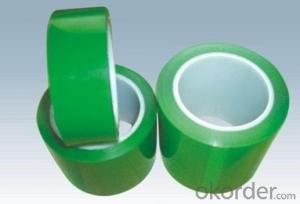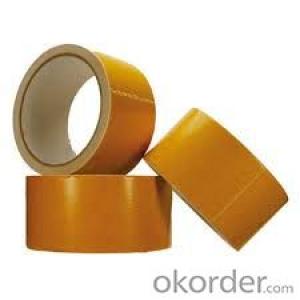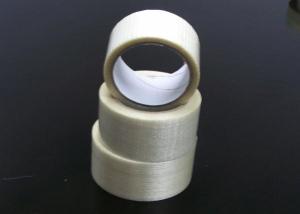Machine Applied Green OPP Packing Tape High Quality Water Based Acrylic
- Loading Port:
- Shanghai
- Payment Terms:
- TT OR LC
- Min Order Qty:
- 50 roll
- Supply Capability:
- 50000 roll/month
OKorder Service Pledge
OKorder Financial Service
You Might Also Like
Quick Details
Material: BOPP film
Adhesive Side: Single Sided
Adhesive: Water Based Acrylic
Use: Carton Sealing and Packing,Light Duty Packing,Bounding,Holding and other office and household use
Design Printing: Offer Printing
Place of Origin: China (Mainland)
Model Number: High Quality Colorful Printing Opp Adhesive Packing Tapes
Color: Clear, Tan, Yellowish, Brown, Yellow, White, Black, Blue, Green, Red etc.
Standard Size: 48mm x 66m, 50mm x 50m, 1.28m x 4000m, etc
Product Discription


Applications
Economical for general carton sealing
Auto-packing machine
Gift Wrapping & Decoration
Bundling &Strapping
Meet all kinds of transportation convenientl
Advantages:
OPP tape, superb tack and adhesion to surface
Strong grip that is ensured because of an excellent adhesive backing
Quality processing equipment that guarantees consistent quality
Peak performance even under extereme conditions of pressure and temperature
Sticks on all types of surfaces (paper, plastic, wood, glass, fiber and metal)
Consistent quality
On time delivery
Effective and timely communication
- Q: Does packaging tape have a specific adhesive strength?
- Yes, packaging tape does have a specific adhesive strength. The adhesive strength of packaging tape refers to how well it sticks to surfaces. This strength is typically measured in ounces per inch (oz/in) or pounds per inch (lb/in). The adhesive strength of packaging tape is determined by various factors, such as the type of adhesive used, the thickness of the tape, and the quality of the backing material. Different types of packaging tape may have different adhesive strengths to cater to specific needs, such as lightweight packages or heavy-duty shipments. It is important to consider the intended use and the weight of the package when choosing packaging tape with the appropriate adhesive strength.
- Q: What materials are commonly used for packaging tape?
- Packaging tape plays a vital role in securing and sealing packages for shipping, storage, or general handling. It comes in various materials, each with its own unique features and benefits. The commonly used materials for packaging tape are as follows: 1. Polypropylene (PP): PP is widely used due to its affordability and versatility. It is a durable thermoplastic polymer that offers excellent resistance to moisture, chemicals, and UV radiation. PP tape is available in different thicknesses and can be transparent or colored. 2. Polyvinyl Chloride (PVC): PVC tape is known for its superior strength and durability. It can withstand water, chemicals, and extreme temperatures, making it suitable for different environments. PVC tape is often used for heavy-duty applications or when extra security is needed. 3. Polyester (PET): PET tape is made from a strong and durable synthetic polymer that provides excellent tensile strength and tear resistance. It is commonly used for heavy packages or in applications where high strength is crucial. PET tape is also resistant to UV radiation and moisture. 4. Paper: Paper-based packaging tape is an eco-friendly alternative to plastic tapes. It is made from renewable resources and can be recycled. While not as strong as plastic-based tapes, paper tape offers sufficient adhesion for lightweight or non-fragile packages. Moreover, it can be easily torn by hand, which is convenient for users. 5. Gummed Tape: Also known as water-activated tape or reinforced tape, gummed tape is made of kraft paper with a starch-based adhesive on one side. It requires water to activate the adhesive, creating a strong bond that is tamper-evident and resistant to tampering. Gummed tape provides a secure seal and is often used for heavy packages or in industries where security is a top priority. In summary, the choice of packaging tape material depends on specific requirements such as package weight, environmental conditions, and desired level of security.
- Q: Can packaging tape be used on different materials?
- Indeed, various materials can be affixed with packaging tape. Packaging tape exhibits versatility as it can adhere to a broad spectrum of surfaces, encompassing cardboard, plastic, metal, glass, and even fabric. Its primary purpose is to yield a robust and steadfast seal, guaranteeing the preservation of packages throughout their journey and storage. Whether one aims to seal a cardboard box, consolidate multiple items, or fasten a package, packaging tape proves to be an efficacious option for an array of materials.
- Q: What are the common sizes of packaging tape?
- The common sizes of packaging tape typically range from 1.88 inches to 3 inches in width, while the length can vary depending on the brand and type of tape.
- Q: How does packaging tape differ from masking tape?
- Packaging tape and masking tape are distinct types of tapes serving different purposes and possessing unique traits. Specifically intended for sealing and securing packages or boxes, packaging tape finds common use in the shipping and packaging industries. It is typically constructed from robust and long-lasting materials like polypropylene or PVC, ensuring exceptional adhesion and resistance against tearing or splitting. Its notable high tensile strength guarantees the package remains securely sealed during transit or storage. Moreover, packaging tape generally boasts a potent adhesive that adheres well to various surfaces, including cardboard, plastics, and metals. It is available in different widths and lengths to accommodate diverse packaging requirements. In contrast, masking tape primarily finds application in painting and DIY projects. Composed of a thinner and less resilient material, such as crepe paper, it possesses a less aggressive adhesive in comparison to packaging tape. The primary objective of masking tape is to establish clean, straight lines and safeguard surfaces from paint or other liquids during painting tasks. Masking tape can be effortlessly applied and removed without leaving any residue or causing damage to the surface. Furthermore, it is recognized for its ability to conform to uneven surfaces, enabling precise masking and detailing work. To summarize, packaging tape is designed for secure sealing and packaging of boxes and packages, whereas masking tape is primarily utilized for painting and surface protection. Packaging tape is stronger, more durable, and possesses a more potent adhesive, whereas masking tape is thinner, more flexible, and can be effortlessly removed without leaving any residue.
- Q: Does packaging tape come in different patterns or designs?
- Yes, packaging tape does come in different patterns and designs. While traditional packaging tape is usually plain and transparent, there are also various options available for those who want to add a touch of creativity or personalization to their packages. Some common patterns and designs include bold colors, stripes, polka dots, floral prints, geometric designs, and even custom logos or messages. These decorative tapes can be a fun and unique way to enhance the appearance of your packages and make them stand out. Furthermore, some packaging tape brands offer seasonal or themed designs, allowing you to match your packaging tape to specific occasions or holidays.
- Q: Can packaging tape be used for sealing documents or important papers?
- Packaging tape is not recommended for sealing documents or important papers. It is primarily designed for securing packages, boxes, or cartons during transportation. For important papers, it is advisable to use archival quality materials like document sealing tape, acid-free folders, or document wallets to ensure their protection and longevity.
- Q: Does packaging tape come in different materials for specific applications?
- Yes, packaging tape does come in different materials for specific applications. One common type of packaging tape is made of polypropylene, which is a versatile material suitable for general-purpose packaging. It is strong, durable, and resistant to moisture and temperature changes, making it suitable for a wide range of applications. However, for more specialized uses, different materials may be needed. For example, if you are packaging items that require extra security or tamper-evident features, you may opt for security tape. This type of tape is often made of a thicker and stronger material, such as polyester or reinforced paper, and is designed to leave a visible mark or message when tampered with. In certain cases, you may need to use packaging tape that is specifically designed for use in extreme temperature conditions. For instance, if you are shipping goods that will be exposed to freezing temperatures, you may need to use freezer-grade packaging tape that remains adhesive and effective in low temperatures. Similarly, some applications may require tape that can adhere to difficult surfaces like corrugated cardboard or recycled materials. In such cases, you may choose a packaging tape with aggressive adhesive properties or one that is specifically formulated for adhesion on challenging surfaces. Additionally, there are also eco-friendly options available for those who prioritize sustainability. Environmentally friendly packaging tapes are often made from renewable or recycled materials and use non-toxic adhesives. Overall, the choice of packaging tape material depends on the specific needs of the application, such as security, temperature resistance, surface compatibility, or environmental considerations. It is always important to select the appropriate tape to ensure the safe and secure packaging of your items.
- Q: Can packaging tape be used for sealing moving boxes?
- Yes, packaging tape is commonly used for sealing moving boxes. It provides a strong and secure seal, ensuring that the boxes remain closed and the contents are protected during transportation.
- Q: Can packaging tape be used for packing fragile items?
- Yes, packaging tape can be used for packing fragile items. It provides a secure seal and helps to protect delicate objects during transportation or storage. However, it is recommended to use additional protective materials, such as bubble wrap or foam, to further cushion and safeguard fragile items.
Send your message to us
Machine Applied Green OPP Packing Tape High Quality Water Based Acrylic
- Loading Port:
- Shanghai
- Payment Terms:
- TT OR LC
- Min Order Qty:
- 50 roll
- Supply Capability:
- 50000 roll/month
OKorder Service Pledge
OKorder Financial Service
Similar products
Hot products
Hot Searches


























